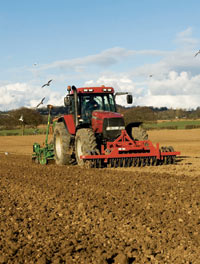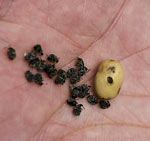Bean drilling to continue until Christmas

Agronomy advice was on the agenda of the PGRO/Syngenta Profit from Protein Production roadshow held in Peterborough last week.
Don’t drill winter beans beyond Christmas, Jim Scrimshaw of PGRO advised growers at a recent PGRO/Syngenta Profit from Protein Production roadshow.
“Consider the festive period as the cut-off point. The right conditions at planting are essential for crop success.”
Both soil compaction and waterlogging could cause problems, he added. “The roots simply can’t penetrate compacted soils. And with waterlogging, trouble begins after just 24 hours and the roots start to break down after 48 hours.”
Going early when conditions are dry was always preferable, Mr Scrimshaw said. “The recommended plant population for winter beans is 18 plants/sq m. For spring beans, it’s higher at 35-40 plants/sq m.”
Growers planning to drill spring beans could protect them from downy mildew, thanks to an off-label approval for Wakil seed treatment, pointed out his colleague, Anthony Biddle.
“If you get 10% leaf infection, yields are reduced by as much as 30%,” he said. “That equates to a loss of £216/ha on a 4t/ha crop, so where downy mildew is a threat it’s worth doing.”
Otherwise, seed treatments weren’t necessary on beans, he said.
Two new pre-emergence herbicides, Lingo and Afalon, were available to growers this year, added Mr Scrimshaw.
“Of the two, Lingo looks very useful. It’s a linuron/clomazone mix and seems to be on a par with established choices, Skirmish and Nirvana. Afalon contains straight linuron, so also has a place in pulse crops.”
Mr Scrimshaw reminded growers about pendimethalin use. “It works well on polygonums, but remember that if it’s wet after application, you will get some leaf distortion and cupping.”
Bruchidcast
 A new modelling system should help growers avoid bean shot-holing.
A new modelling system should help growers avoid bean shot-holing.
A new forecasting model for bruchid beetle is being developed by PGRO and Syngenta, with testing planned for this coming year.
The model worked on the knowledge that spraying should take place after two consecutive days at 20C at flowering, with a follow-up treatment needed seven days later, explained Dr Biddle.
“The model will not only help growers to identify temperature thresholds, it will also highlight available spray days,” he said.
By combining weather data with beetle risk prediction and spray forecasting, BruchidCast will allow growers to plan spray applications with greater accuracy.
Changes to Bravo label
Pulse growers had until 31 August 2010 to buy any remaining stocks of Bravo 500 with the MAPP number 10518, said Bruce Mackenzie of Syngenta.
The use up period extends until 31August 2011, after which the company will have introduced new chlorothalonil mixes.
“It’s part of our voluntary stewardship programme to safeguard the long term future of chlorothalonil. In pulse crops, we are moving from the use of straight chlorothalonil to pre-mix solutions – that way the overall usage of chlorothalonil should go down.”
The new label Bravo would be for wheat and barley only, confirmed Mr Mackenzie.
Coded product A14111B, which will go under the brand name of Olympus once it had received registration, was an Amistar and Bravo mix, he said.
“We see it having a place in both peas and beans against a range of diseases. Until it’s available, growers can still make use of Amistar +old label Bravo.”

